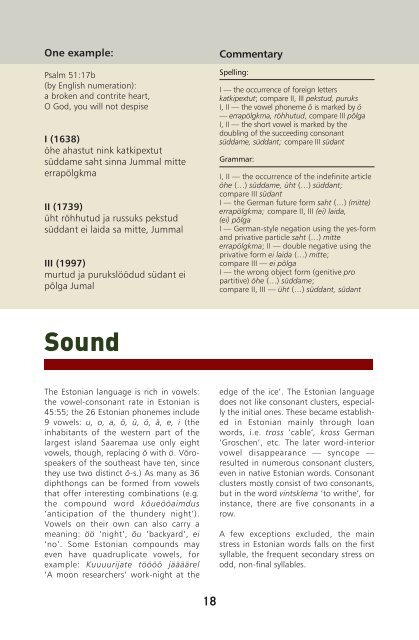Create successful ePaper yourself
Turn your PDF publications into a flip-book with our unique Google optimized e-Paper software.
One example:<br />
Psalm 51:17b<br />
(by English numeration):<br />
a broken and contrite heart,<br />
O God, you will not despise<br />
I (1638)<br />
öhe ahastut nink katkipextut<br />
süddame saht sinna Jummal mitte<br />
errapölgkma<br />
II (1739)<br />
üht röhhutud ja russuks pekstud<br />
süddant ei laida sa mitte, Jummal<br />
III (1997)<br />
murtud ja purukslöödud südant ei<br />
põlga Jumal<br />
Commentary<br />
Spelling:<br />
I — the occurrence of foreign letters<br />
katkipextut; compare II, III pekstud, puruks<br />
I, II — the vowel phoneme õ is marked by ö<br />
— errapölgkma, röhhutud, compare III põlga<br />
I, II — the short vowel is marked by the<br />
doubling of the succeeding consonant<br />
süddame, süddant; compare III südant<br />
Grammar:<br />
I, II — the occurrence of the indefinite article<br />
öhe (…) süddame, üht (…) süddant;<br />
compare III südant<br />
I — the German future form saht (…) (mitte)<br />
errapölgkma; compare II, III (ei) laida,<br />
(ei) põlga<br />
I — German-style negation using the yes-form<br />
and privative particle saht (…) mitte<br />
errapölgkma; II — double negative using the<br />
privative form ei laida (…) mitte;<br />
compare III — ei põlga<br />
I — the wrong object form (genitive pro<br />
partitive) öhe (…) süddame;<br />
compare II, III — üht (…) süddant, südant<br />
Sound<br />
The Estonian language is rich in vowels:<br />
the vowel-consonant rate in Estonian is<br />
45:55; the 26 Estonian phonemes include<br />
9 vowels: u, o, a, õ, ü, ö, ä, e, i (the<br />
inhabitants of the western part of the<br />
largest island Saaremaa use only eight<br />
vowels, though, replacing õ with ö. Võrospeakers<br />
of the southeast have ten, since<br />
they use two distinct õ-s.) As many as 36<br />
diphthongs can be formed from vowels<br />
that offer interesting combinations (e.g.<br />
the compound word kõueööaimdus<br />
‘anticipation of the thundery night’).<br />
Vowels on their own can also carry a<br />
meaning: öö ‘night’, õu ‘backyard’, ei<br />
‘no’. Some Estonian compounds may<br />
even have quadruplicate vowels, for<br />
example: Kuuuurijate töööö jäääärel<br />
‘A moon researchers’ work-night at the<br />
edge of the ice’. The Estonian language<br />
does not like consonant clusters, especially<br />
the initial ones. These became established<br />
in Estonian mainly through loan<br />
words, i.e. tross ‘cable’, kross German<br />
‘Groschen’, etc. The later word-interior<br />
vowel disappearance — syncope —<br />
resulted in numerous consonant clusters,<br />
even in native Estonian words. Consonant<br />
clusters mostly consist of two consonants,<br />
but in the word vintsklema ‘to writhe’, for<br />
instance, there are five consonants in a<br />
row.<br />
A few exceptions excluded, the main<br />
stress in Estonian words falls on the first<br />
syllable, the frequent secondary stress on<br />
odd, non-final syllables.<br />
18


